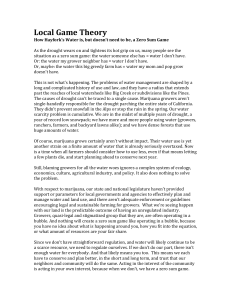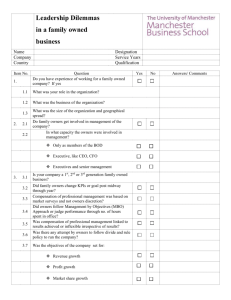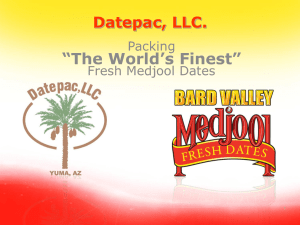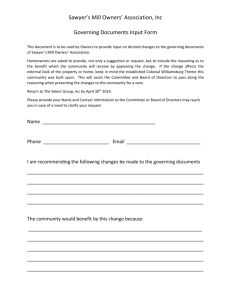A New Business Structure
advertisement
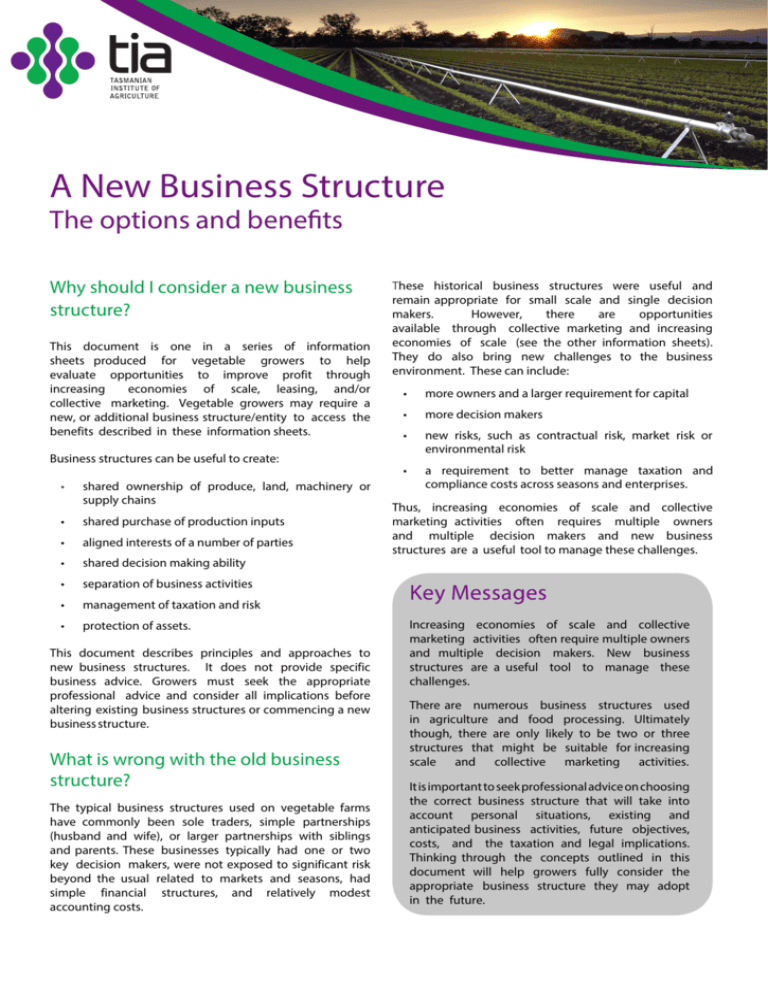
A New Business Structure The options and benefits Why should I consider a new business structure? This document is one in a series of information sheets produced for vegetable growers to help evaluate opportunities to improve profit through increasing economies of scale, leasing, and/or collective marketing. Vegetable growers may require a new, or additional business structure/entity to access the benefits described in these information sheets. Business structures can be useful to create: • shared ownership of produce, land, machinery or supply chains • sharedpurchaseofproductioninputs • alignedinterestsofanumberofparties • shareddecisionmakingability • separationofbusinessactivities • managementoftaxationandrisk • protectionofassets. This document describes principles and approaches to new business structures. It does not provide specific business advice. Growers must seek the appropriate professional advice and consider all implications before altering existing business structures or commencing a new business structure. What is wrong with the old business structure? The typical business structures used on vegetable farms have commonly been sole traders, simple partnerships (husband and wife), or larger partnerships with siblings and parents. These businesses typically had one or two key decision makers, were not exposed to significant risk beyond the usual related to markets and seasons, had simple financial structures, and relatively modest accounting costs. These historical business structures were useful and remain appropriate for small scale and single decision makers. However, there are opportunities available through collective marketing and increasing economies of scale (see the other information sheets). They do also bring new challenges to the business environment. These can include: • moreownersandalargerrequirementforcapital • moredecisionmakers • new risks, such as contractual risk, market risk or environmental risk • a requirement to better manage taxation and compliance costs across seasons and enterprises. Thus, increasing economies of scale and collective marketing activities often requires multiple owners and multiple decision makers and new business structures are a useful tool to manage these challenges. Key Messages Increasing economies of scale and collective marketing activities often require multiple owners and multiple decision makers. New business structures are a useful tool to manage these challenges. There are numerous business structures used in agriculture and food processing. Ultimately though, there are only likely to be two or three structures that might be suitable for increasing scale and collective marketing activities. It is important to seek professional advice on choosing the correct business structure that will take into account personal situations, existing and anticipatedbusiness activities, future objectives, costs, and the taxation and legal implications. Thinking through the concepts outlined in this document will help growers fully consider the appropriate business structure they may adopt in the future. What are the options and what are the considerations? The following diagram shows a range of business structures. The top of the triangle contains the cheaper, simpler and moreflexiblebusinessstructures,whereasthe bottom of the triangle contains more complex structures that are more suited to larger scale production, but have higher compliance costs. Sole Trader Increased risk, increased flexibility to decision making, low asset protection and low compliance costs. Useful for small-scale business. Partnership Joint Venture Trust Responsible Entity Co-operative Private Company Low compliance Association Public Company Decreased risk and flexibility of decisionmaking, high asset protection and high compliance costs. Useful for large-scale business. High compliance There are numerous business structures used in agriculture and food processing. Ultimately though, there are only likely to be two or three structures that might be suitable for increasing scale and collective marketing activities. Some of the major considerations and questions to talk through with your business partners and business advisors when determining your preferred business structure are listed under the following headings. Ownership The ownership of the business is a critical factor. Multiple owners and varying levels of ownership are more easily managed with structures towards the bottom of the triangle. If there is a number of business owners and a possibility of disagreement from time to time, it is critical that agreement is reached on how difficult decisions will be made and how change of ownership will occur. Risk and asset protection Increasing scale to make additional profit and participating in collective marketing with a group of growers, wholesalers or processors can bring additional risk, such as the following: • Contractual risk. A group of growers may, for example,takeoutacontracttosupplyalargevolume and variety of vegetables; this large contract may result in a substantial loss if it is unfulfilled. • Market risk. A group of growers may be selling into a specificdomesticorexportmarketthatissubjecttoa radical change in policy, threat from a large competitor or food scare in the marketplace resulting in poor sales and a loss. • Agricultural risk. A group of growers may be selling vegetable products from a geographic region that has a frost, hail, flood or fire event resulting in significant loss of market share or financial loss. One approach to manage these risks is to ‘compartmentalise’ or isolate different business activities. If one business activity is impacted by a detrimental event, then other related business activities, assets or cash can be protected. If a business arrangement fails, or the weather results in a catastrophic financial loss, then these events should not cause related, profitable business ventures to fail. Setting up a number of different business structures that handle different production enterprises or different segments of the supply chain can be quite useful to manage risk. Compliance costs and tax management Every business structure has a cost associated with formation, annual management and final wind up. Simpler structures such as sole traders or partnerships, tend to have lower costs, whereas the larger structures such as companies or co-operatives, bring larger accounting and compliance bills. It is important to consider the ongoing management costs of each structure and ensure that the structure is appropriate for the scale of the business. Different business structures are also subject to different taxationmechanisms.Thesimplerstructuresand sometrustsrequire annual distributions of profit. Annual distributions can make it more difficult to manage the profit highs and lows in agriculture, whereas company structures have more options for accessing concessional taxratesandretainingprofits. Growers considering a change in business structure need totalkthroughthecosts,taxmanagementandlegal implications with their business advisers before adopting a new structure. Decision making Exit strategy Business owners make strategic decisions about business activities. One consideration in adopting a business structure is ‘who will make the decisions?’ If the business owner(s) want to be very ‘hands on’ and make all the decisions, then a flexible structure towards the top ofthetriangleislikelytobemoresuitable.However,ifthere is a mix of owners and mangers with different roles and responsibilities, then structures towards the bottom of the triangle are likely to be more suitable. A further consideration in forming a new business structure isthatofthe‘exitstrategy’,orhowwillthebusinessowners leave. Is there a requirement for it to grow and raise additional funds in the future? Is there a requirement for the business to include additional owners in the future? Is there a requirement for the business to be sold to someone else? The anticipated exit strategy will have an impact on the type of structure chosen and can impact transfer costs to a third party. How do I proceed with a new business structure? The following headings will help growers consider strategic points in adopting a new or additional business structure. 1. Consider ownership and decision makers Cleary determine the business owners and how they will make decisions, or which spheres of the business each owner will control. A number of questions need to be addressed. • Is it easier for owners to own separate smaller businesses that trade with each other, or can the owners own the entire business together? • Howwilltheownersmakedecisionscollectively? • Willdecisionsbeoutsourcedtomanagers,oroccurby consensus, or will each decision maker be responsible for their own ‘section’ of the business? Considering the ownership and some of the decision making detail will help determine the appropriate business structure. 2. Clearly define the business activities Create a document that describes the business activities. Some things to consider will be: • ownership • managementstructure • growthobjectives • themarketsfortheproductorserviceofferedbythis business • definitionoftheproduct,buyingandsellingcosts, volumes and values • identificationofprofitsandwhichactivitiesare profitable • whetherthenewbusinessissimplytheexisting business with larger scale, or does it use new skills and have different risks? It will be useful to construct a formal business plan. Resources on constructing a business plan are available on the Business Tasmania website. See www.business.tas.gov.au 3. Consider risks and asset protection Construct a list of all possible risks to the new business and describe the impact of each of those risks on your business, yourself and family. Also construct a list of all the existing business activities, risks and impacts of these on the existingactivities. These lists will help your business advisor consider your requirements for asset protection and use of the appropriate business structure to manage risk. 4. Take professional advice It is important to seek professional advice on choosing the correct business structure that will take into account per-sonal situations, existing and anticipated business activities,futureobjectives,costs,andthetaxationandlegal implications. Thinking through the concepts outlined in this document will help growers fully consider the appropriate business structure they may adopt in the future. Tools and further resources Further resources that may be useful when considering business structures include: • IncreasingProductivity-Achievingeconomiesofscaleinvegetableproduction • ScaleofVegetableProduction-Profitcalculator • CollectiveMarketing-Sellingvegetablesprofitably! • LandLeasing • CollaborativeBusinessModels • LegalBusinessStructures • BusinessStructuresinAgriculture–Wealthfromwaterwebpage Disclaimer This business case was produced and edited by Tasmanian Institute of Agriculture (TIA). TIA produces these documents with theexpectationthatusersexercisetheirownskillandcarewithrespecttotheiruse.Beforerelyingonoralteringany business practices, users should carefully evaluate the accuracy and relevance of the information for their purpose and should obtain appropriate professional advice relevant to their particular circumstances. TIA is a joint venture between the University of Tasmania and the Tasmanian Government

